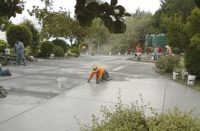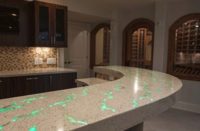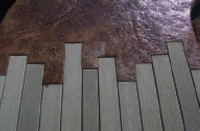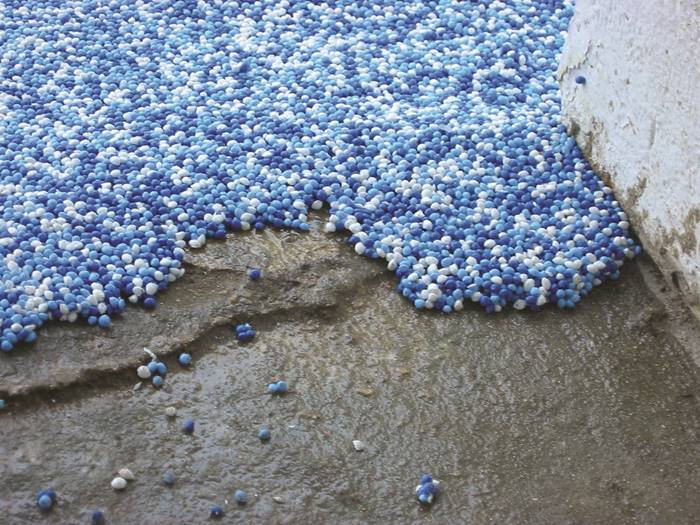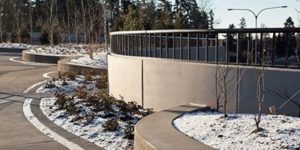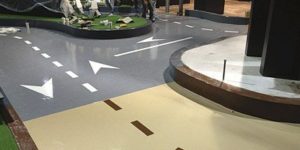
Pebble-Flex Synthetic Rubber Surfacing System. When it comes to putting a soft, springy surface on top of a craggy concrete floor, Pebble-Flex is where the rubber hits the road.
The porous thermoplastic polymer and binder system is made up of countless tiny rubber balls sealed in place. It’s color-stable, user-friendly and environmentally safe.
The thermoplastic rubber shapes measure 2 mm to 4 mm in diameter. “They’re different sizes, so they compact easier,” says Pebble-Flex LLC vice president of sales Rose Saluti. “We don’t want them all the same size.”
Perhaps the most significant quality of these flexible pebbles is how they stand up to the sun. Unlike earlier generations of synthetic rubber surfacing, Pebble-Flex does not degrade from exposure to ultraviolet rays, so it does not suffer premature fading, chalking and decomposition.
One of the key benefits of this system is its ease of installation. Laying Pebble-Flex is a three-step process. A penetrating, adhesive two-part urethane “primer” goes onto the substrate first. The rubber bits are combined in a cement mixer with an aliphatic urethane binder. The resulting mixture pours like cement. The coating can be troweled by hand or machine, with soapy water used to slick the blades. Pebble-Flex does not employ harsh chemicals such as acetone, xylene or kerosene. It bonds to most surfaces the results of applying it over wood, metal or fiberglass is as reliable as applying over concrete.
With Pebble-Flex, damaged surfaces can look new again without any demolition needed. Once you install the surface, you can repair it in minutes. And it won’t recrack. Being thermoplastic urethane, it expands and contracts instead of giving way. “It’s like a whole surface made from an expansion joint,” Saluti says.
Pebble-Flex comes in many options
Pebble-Flex comes in 13 standard colors, and the company offers custom color-matching services to help the surface fit an existing space. The vibrant colors complement playgrounds and pools nicely. you can incorporate logos and designs into the surface. Because of the pebbles’ resistance to UV rays, colors and designs won’t fade. “Bright colors that stay that way is huge,” Saluti says.
Besides playgrounds and swimming pool decks, the surface works well on patios, walkways, driveways and balconies. It is soft, safe and skid-resistant. It’s also comfortable to walk on barefoot, and it conforms to ASTM standards for critical fall heights.
Introduced in 2002, Pebble-Flex is billed as “the first truly light stable soft rubber surfacing material.” Pebble-Flex LLC is currently growing, having recently set up international distribution for the first time, in Australia and New Zealand. “We are still a growing company with an innovative product that has been getting a lot of positive feedback, from many large-scale surfacing companies in the concrete resurfacing industry as well as the playground surface industry,” says Pebble-Flex sales manager Bill McGrath III.
Questions from Readers
Question
Is this product nonpermeable? If it is, once it’s applied to concrete, can moisture get between the product and the substrate or is it sealed? Also, what is the maximum thickness I can apply or build this product up to?
Answer from Concrete Decor
This type of rubber flooring solution on an existing concrete surface begins with a two-part coating that bonds to the substrate. This makes the concrete impenetrable to water that flows through the Pebble-Flex topcoat. The most important consideration when using this type of system is ensuring proper slope with the existing surface. If your concrete has valleys where rain or sprinkler water collects, then you need to cut joints into the existing slab to create an escape route for water.
Question
I have had your coating on our walkway for many years. Recently mold is showing over part of the surface. Is there any chance that we can remove the mold? We have been very pleased with the Pebble-Flex. Can you help?
Answer from Concrete Decor
Thanks for sharing your maintenance concerns with Concrete Decor. Just so you know, we are a concrete industry magazine that provides ongoing advice to our online audience.
Not actually seeing what you’re looking at with regards to mold or mildew, I recommend a 25% bleach-to-water solution that you should spray-apply to the affected areas. Let that sit for a few minutes and follow behind with a light to medium cleaning with a pressure washer. You can repeat this procedure as many times as you like to properly clean the surface while also killing any hidden mildew below the surface. Thoroughly rinse to remove dirt and you should be good for a while.
